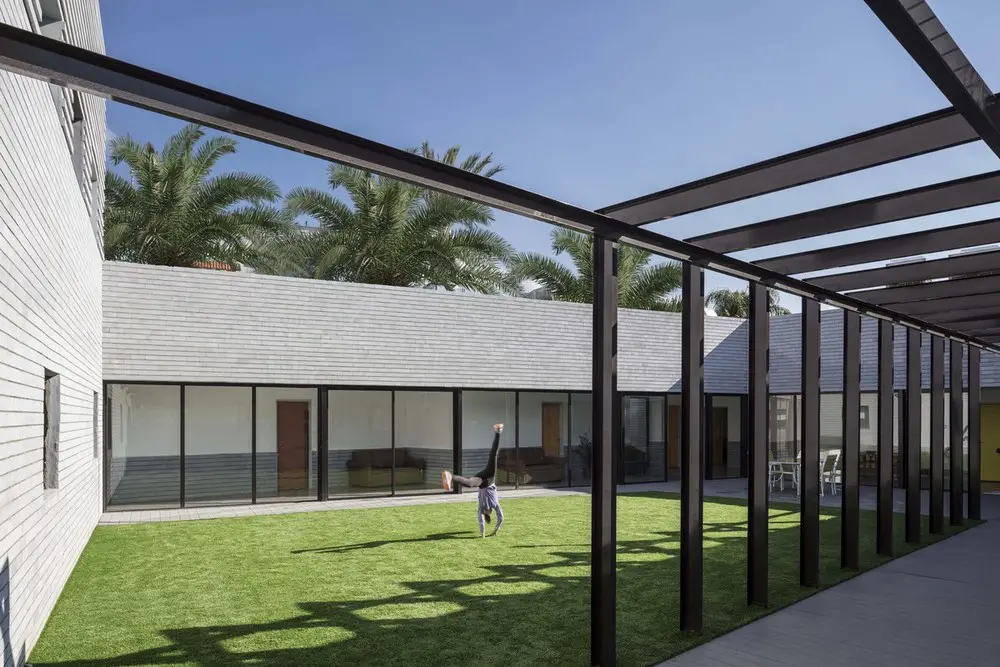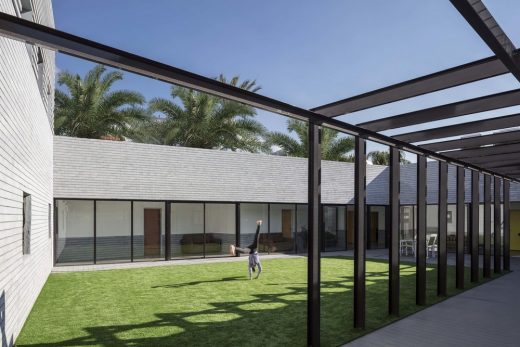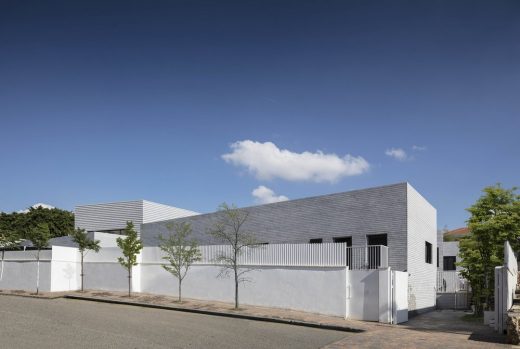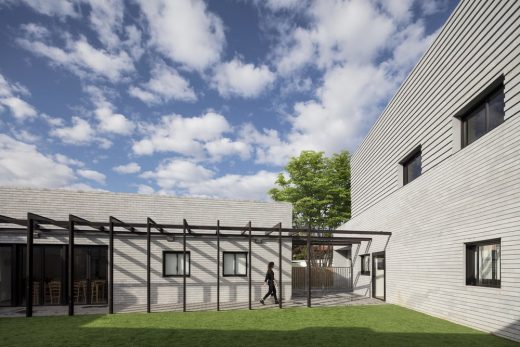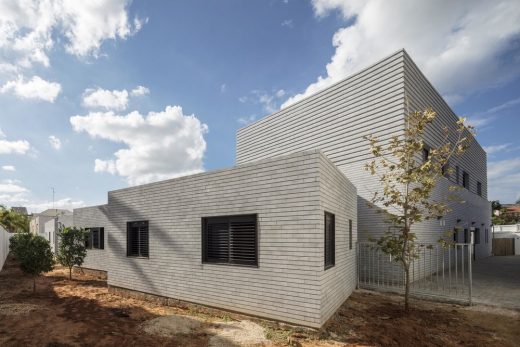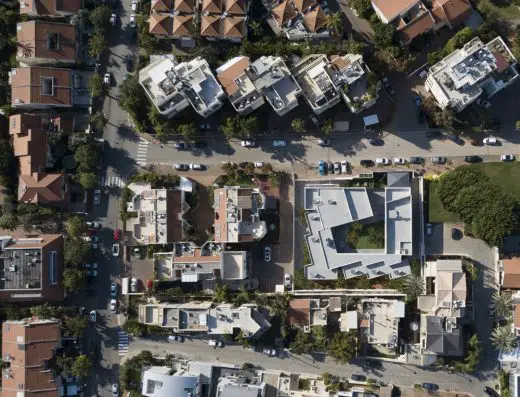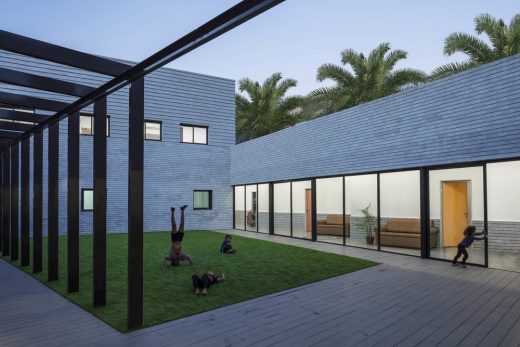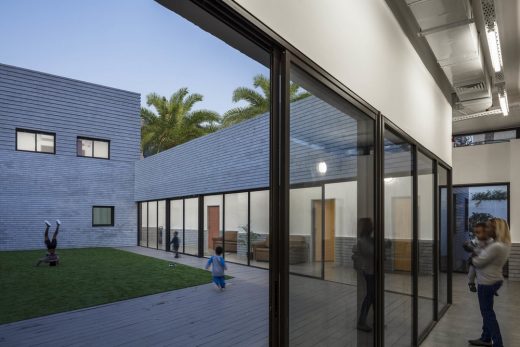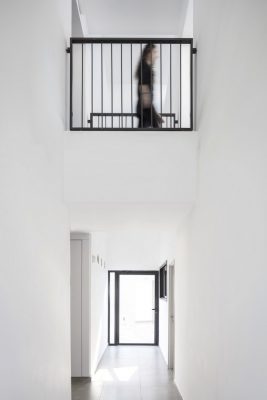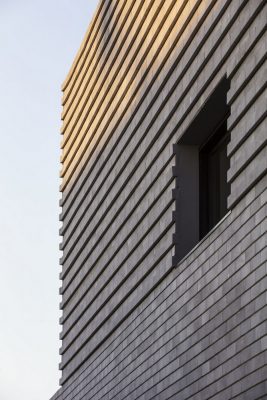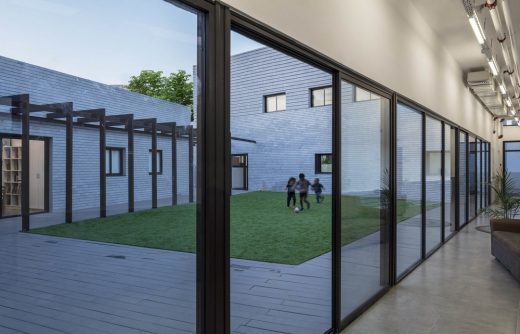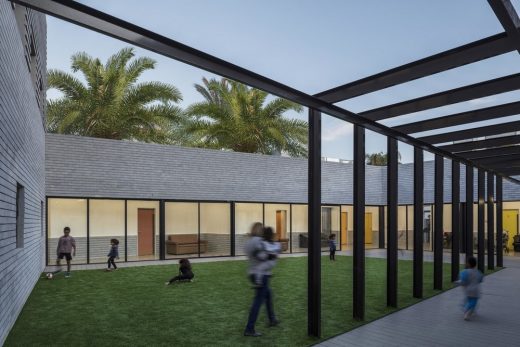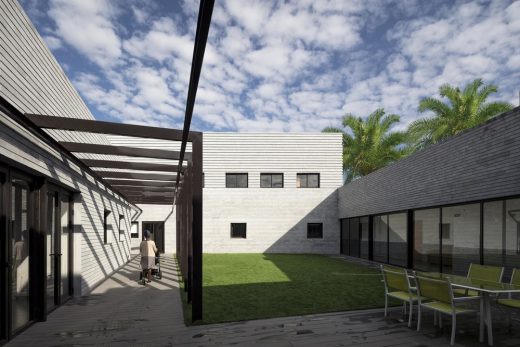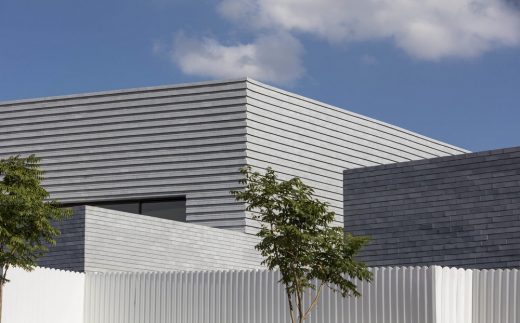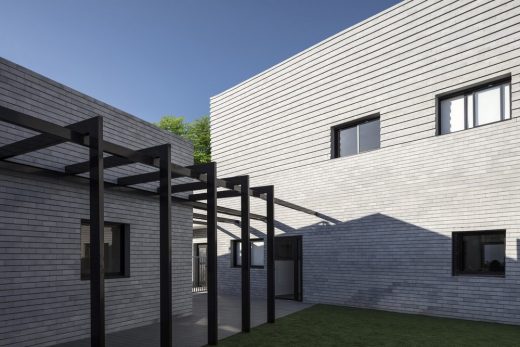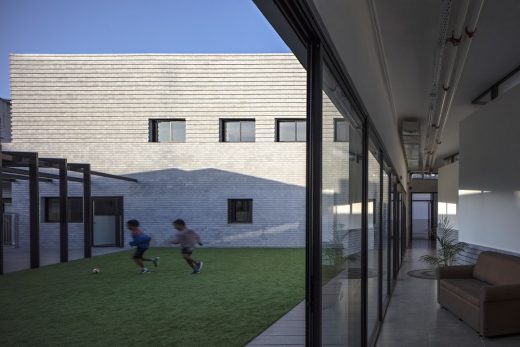Shelter for Victims of Domestic Violence, Residential Building, Architecture, Housing Images, Architect
Shelter for Victims of Domestic Violence near Tel-Aviv
New Housing Project in Israel design by Amos Goldreich Architecture
9 Feb 2020
The Ada and Tamar House
Design: Amos Goldreich Architecture
Location: near Tel-Aviv, Israel
The Ada and Tamar House
Designed by London-based practice, Amos Goldreich Architecture, alongside local firm, Jacobs-Yaniv Architects, this shelter is one of only a handful in the world which has been designed and built in consultation with the staff who will occupy and run it. Led by pioneering human rights activist, Ruth Rasnic, for international charity ‘No To Violence’, the facility will provide a much-needed refuge for distressed and abused women and children from all localities and backgrounds.
According to World Health Organisation data up to 45% of women in Israel, like most countries in the west, will be victims of domestic violence at some stage in their lives and recent statistics indicate that 45% of children in Israel are subjected to violence. This is a worldwide epidemic.
“My family wanted to create something worthwhile in memory of my late grandmother Ada, a feminist who was involved in many charities in Israel,” says Amos Goldreich, Director of Amos Goldreich Architecture. “They approached Ruth Rasnic, a childhood friend of my late mother, who founded the charity ‘No To Violence’ in 1977, in order to raise public awareness about domestic abuse in Israel, as well as provide support for victims. That is how the project started.”
The charity currently operates three shelters, and whilst it foots 60% of ongoing expenses, the government does not assist with building expenditure.
This will be the charity’s first purpose-built shelter, as well as accommodating its administrative headquarters, and has been designed to house families from diverse ethnic and geographical backgrounds, including Arab, Israeli, Ethiopian, Russian and Ukrainian women and children.
The site for the shelter measures 1600 square metres, is located within a quiet residential neighbourhood and surrounded by a mix of private residential houses and blocks of flats. The brief specified a location within reach of local community resources, i.e. stores, jobs, health clinics, schools, parks and other green spaces, counselling centres and recreational facilities.
The new shelter replaces an existing one in the same city which was established 37 years ago. The majority of existing shelters in Israel are not purpose-built. Located in converted buildings, they are overcrowded, with too many stairs and blind areas, compromising the safety of the residents. The new brief thus called for a totally secure and sheltered building – a peaceful haven that would give its inhabitants a sense of home.
The site was provided by the local municipality, but this proved a challenge, as local neighbours objected to it. Numerous consultations with neighbours and the municipality took place, including reviews of the residents’ legal objections to the scheme by the High Court which went on for six years, before it ruled in favour of the shelter.
We were two briefs: one was set out by the Ministry of Social Affairs, the other, which complemented it, by the charity. The charity was very involved in the development of the brief and the design discussions, stipulating that the shelter needed to accommodate up to twelve families, all of whom require individual privacy, yet need to coexist with each other and with the staff who look after them. Each family has three children on average, so the design of the building was predicated on a floating population of more than 24 residents at any one time.
Another paramount request was to create a sense of home and security for the inhabitants, without it feeling like a prison. For safety reasons, residents spend most of their day in the shelter, and so the major design challenge was how to accommodate all families in a peaceful manner for extended periods of time.
The building has two facades – the secure and protective exterior, and the inner façade, giving onto the central garden, the therapeutic “heart” of the shelter.”
On arrival at the shelter, each new family is given a small ‘house’ that is part of the larger building. In order to allow the families to conduct a normal daily routine in the shelter, the ‘houses’ are separated from the communal functions and connected by the internal corridor. The nursery is physically separated from the larger building, which allows it to function as an ordinary nursery would, allowing women to drop their children off in the mornings, and collect them later in the day.
The green sanctum of the inner courtyard plays a crucial role as a meeting place for the residents. It also serves a functional purpose, providing optimum visual connections between the house mother and the families, as well as between the women and their children. The surrounding internal corridor (or ‘street’) connects the inside and outdoor spaces and creates a free-flowing space in which women and children can interact, while at the same time maintaining mutual sight lines between them and the staff.
Ruth Rasnic, the charity’s founder, said: “The shelter will provide a much-needed refuge for abused women – they arrive in a state of real distress, these people have deep psychological problems, as do their children, so the shelter must provide them with a tangible sense of calm and security. The architects have created a miracle, really, a place where people of disparate backgrounds can come to terms with their individual trauma, where we can help rebuild their lives, give guidance and support during a key period of transition. And we have many success stories. This is just one example of the work achieved by ‘No To Violence’. This new shelter will make a huge contribution to the ongoing work of our charity.”
Sadly, this is one of only few examples of a purpose-built shelter in Israel and elsewhere in the world which was designed with input from the staff who will run it in order to address the specific needs of its residents. Amos Goldreich’s aspiration is that it shows the possibility, despite limited funding in this sector, of producing a beautiful and functional building, worthy of its inhabitants and employees.
Amos Goldreich: “This is a unique project and we feel very privileged to have delivered it – not just because it has been an exciting challenge architecturally, but because of the impact it will have on the lives of women and children who have been victims of unimaginable trauma and abuse. Perhaps we can also prove that this is a sustainable model for other refuge shelters all over the world? In the UK, we hear about the funding cuts to refuge shelters almost daily in the news.
I was horrified to read that over 200 women in the UK seeking refuge are turned away every day – violence towards women is a worldwide epidemic, and we need to do more to face that reality, starting at the top. As a start, we hope our practice has gone some way to demonstrate what is possibly with limited funding and difficult stakeholders. We would love to inspire the implementation of other socially-minded projects that represent an architecture of hope.”
The architects were given two briefs: one was set out by the Ministry of Social Affairs, the other, which complemented it, by the charity. The charity was very involved in the development of the brief and the design discussions, stipulating that the shelter needed to accommodate up to twelve families, all of whom require individual privacy, yet need to coexist with each other and with the staff who look after them. Each family has three children on average, so the design of the building was predicated on a floating population of more than 24 residents at any one time.
The very limited budget was a challenge from the very beginning. The site was provided by the local municipality, but this proved a challenge, as local neighbours objected to it. Numerous consultations with neighbours and the municipality took place, including reviews of the residents’ legal objections to the scheme by the High Court which went on for six years, before it ruled in favour of the shelter.
The materials are all sustainable, durable and low maintenance, with special attention paid to the landscaping scheme which features indigenous planting. The building’s environmental strategy is highly sustainable – the building materials have been locally sourced, key areas are naturally ventilated and mechanical ventilation systems are highly energy efficient. The shelter also uses solar panels to heat all water.
We were faced with the challenge of a very tight budget from the outset, as well as a brief which called for a low-maintenance building, robust enough to withstand weathering and potential misuse. These criteria had to be addressed in the choice of materials and detailing.
The weather in central Israel is such that in the summer temperatures can reach the high 30s (Celsius), dropping to mid-20s during the night, usually with high humidity, whereas in the winter temperature can vary significantly between day and night. Thermal mass construction is therefore the most commonly used and cost-effective route.
The constructional build-up and detailing used included RC in-situ concrete slabs and a mixture of RC and concrete blocks for the walls. Externally, the walls are clad in silicate bricks, which are produced locally. They were chosen for their durability, accuracy and uniform appearance, the latter being more suitable for the location of the building. This cladding appears also internally, enhancing the flow between external and internal spaces. On the two-storey volume, the bricks on the first floor change pattern, rendering the big volume less dominant and more slight in scale.
The roof slab above the internal corridor and dining hall is raised to form a series of clerestory windows, allowing indirect light to penetrate and also differentiating these spaces from other, more private functions.
All the AC ducting to the rooms is located on the roof to allow for a maximum internal head room without any compromise on comfort and the use of the spaces.
The Ada and Tamar House, Tel-Aviv – Building IOnformation
Architect: Amos Goldreich Architecture
Project size: 850 sqm
Site size: 1600 sqm
Project Budget: $1200000
Completion date: 2018
Building levels: 2
Photography: Amit Gosher
Residential Building in Tel-Aviv images / information from architect
Location: Tel Aviv, Israel, Middle East
Israel Architecture Designs
Contemporary Israel Architectural Selection
Tel Aviv Architecture Walking Tours
Latest Tel Aviv Buildings
Residential Building in Tel-Aviv
Eco-Tubes – Azriel Faculty of Design’s Workshops Building, Ramat Gan, Tel Aviv District
Design: Geotectura Studio
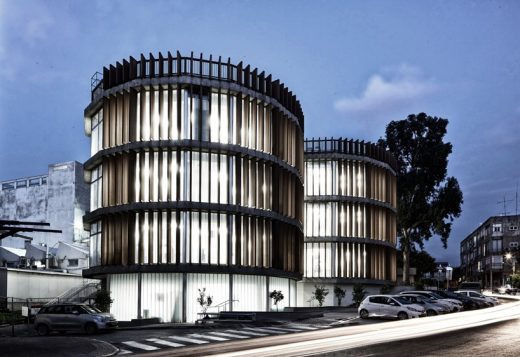
photo : Lior Avitan
Azriel Faculty of Design’s Workshops building
Israeli Architecture
Mount Herzl Memorial Hall
Design: Kimmel Eshkolot Architects in collaboration with Kalush Chechick architects
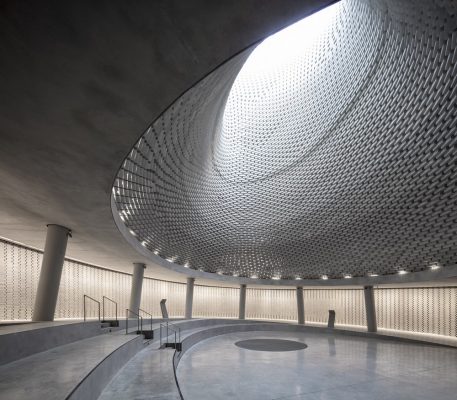
photo © Amit Geron
RIBA Awards for International Excellence 2018
Eco360 Energy Positive Villa, Arsuf, central Israel
Design: Geotectura Studio
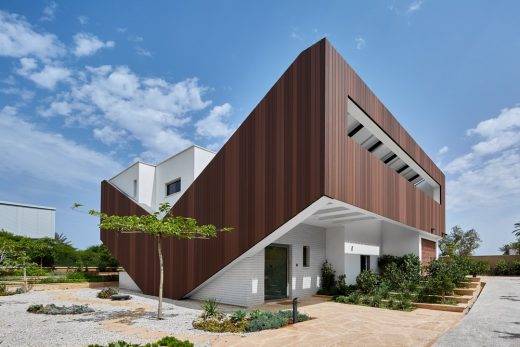
photo : Lior Avitan
Eco360 Energy Positive Villa
Comments / photos for the Residential Building in Tel-Aviv page welcome

